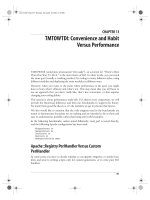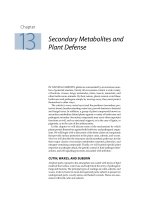Lecture Discovering nutrition - Chapter 13: Food safety and technology
Bạn đang xem bản rút gọn của tài liệu. Xem và tải ngay bản đầy đủ của tài liệu tại đây (1.72 MB, 19 trang )
Chapter 13
Food Safety and
Technology:
Microbial Threats
and Genetic
Engineering
Food Safety
• Harmful substances in foods
– Pathogens
• Bacteria, viruses, parasites
– Foodborne illness
• Infection from pathogen
• Toxin produced by microorganism
Food Safety
• Harmful substances in food pathogens
– Staphylococcus aureus
– Clostridium botulinum
– Salmonella
– Escherichia coli
• Prions and mad cow disease
Food Safety
• Harmful substances in food
– Chemical contamination
• Pesticides
– Important role in food production
– Concerns: pollution of soil and
water
– Threatens wildlife
Food Safety
rganic alternatives
– “USDA Organic” Seal
– Concerns regarding natural fertilizer
– Can use approved pesticides
nimal drugs
– Antibiotics
– Drug residues
ollutants
Food Safety: Harmful Substances
• Natural toxins
– Aflatoxins
– Ciguatera
– Methyl mercury
– Poisonous mushrooms
– Solanine
• Other food contaminants
Keeping Food Safe: Food
Industry
• Hazard Analysis Critical Control Point (HACCP)
– Analyze hazards
– Identify critical control points
– Establish preventive measures with critical
limits
– Establish procedures to monitor control points
– Establish corrective actions if critical limit isn’t
met
– Establish effective record keeping
– Establish procedures to verify that the system
is working consistently
Keeping Food Safe: Consumer
• Keep hot foods hot
and cold foods cold
Keeping Food Safe: Consumer
•
•
•
•
Clean
Separate
Cook
Chill (refrigerate promptly)
Risk for Foodborne Illness
•
•
•
•
•
•
•
Immune disorders
Cancer
Diabetes
Long-term steroid use
Liver disease
Hemochromatosis
Stomach problems
Food Technology
• Food preservation
– Preservatives
• Salt, sugar
• Antioxidants
– Other preservation techniques
• Salting
• Fermenting
• Drying
• Canning
• Heating (e.g.,
pasteurization)
•
Food Technology
• Bacteriophage
– Food additive use to protect people from
bacterial infections
• “Bacteria eaters”
Genetically Modified Foods
• Plant genetics
– Traditional breeding
• Cross two plants and develop hybrids;
takes time
– Genetic engineering
• Transform specific genes
• Less time needed to get desired effects
Genetically Modified Foods
• Benefits of genetic engineering
– Enhanced plant growth
– Reduced pesticide and fertilizer use
– Enhanced nutrient composition
– Enhanced crop yields
• Risks
– Potential for new allergens
– Herbicide-resistant weeds
– Loss of biodiversity
Genetically Modified Foods
• Regulation
– FDA oversees genetically modified foods
– Label requirements
• If food is significantly different









